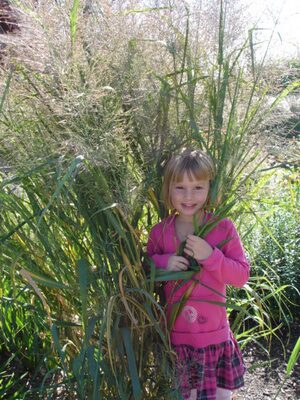Ornamental grasses are becoming more popular. Dozens of ornamental grasses are now available, and new forms are being introduced each year. The reasons for this astonishing rise in popularity appear to center around the practicability, as well as the aesthetic merits of ornamental grasses. As the public becomes more environmentally aware, and learns more about low maintenance plants and sustainable landscapes, ornamental grasses that can tolerate extremes of drought and wetness are eagerly sought. Many ornamental grasses are also able to endure the extreme winters in Iowa. Ornamental grasses are also a part of the growing popularity of water gardening, as transitional elements between dry land and water.

Ornamental grasses, in both foliage and inflorescence (seed head), vary greatly in size, shape, color and texture. Mature plants range in height from 6 inches (blue sedge, Carex glauca) to 14+ feet (hardy pampas, Saccharum ravennae). Grass forms vary from low mounding to fountain shaped to tall vertical. Foliage color includes shades of green, yellow, blue, red, brown and variegated (green and white mixed). A number of grasses change in foliage color in the fall, to displays of straw yellow, orange, red or purple, providing a wealth of choices. Foliage texture varies from fine to coarse (blade width from 1/8 to 1 inch). The inflorescence also varies in size and color, and may change color in the fall as well.
Although a few grasses tolerate shade, most require full sun. Some grasses or grasslike plants tolerate wet soils, but more require a well-drained soil. To become drought and pest resistant, plants require a suitable root zone. In compacted soils, even the root systems of the most drought-tolerant plants will not develop. Incorporate organic matter into the root zone to improve water-holding capacity and oxygen levels. Adequate organic matter will develop a soil with sufficient pore size to readily release water. The improved root zone will allow for maximum root expansion and water extraction from the soil. Improving the soil also will reduce irrigation frequency. Your investment in soil improvement will be returned in fewer maintenance problems and more attractive, longer-lived plants.
In contrast to other flowering perennials, ornamental grasses require minimum maintenance and most species are both insect and disease resistant. However, improperly sited plants may become diseased because of poor air movement, high nitrogen soils or inadequate light. As ornamental grasses become more common, pest problems may develop. At that point, cultivar selection will be more important.
As with most plants, there are common myths or misunderstandings about the ornamental grasses. For example, many durable and hardy ornamental grasses are mistakenly called Pampas grass. Cortaderia selloana, the only true Pampas grass, will not recommended in our area due to being invasive.
The first question to ask about a grass: is it rhizomatous (spreading by underground stems) or clump forming? Rhizomatous types make excellent ground covers, erosion control plants, and dense cover plantings that resist the invasion of weeds. The rhizomatous types spread at different rates laterally, some as much as twelve or more feet a year, and may be invasive. The clump formers simply increase in circumference, requiring division every three or four years. Distinguishing between the two types and locating them in proper sites will prevent a great deal of difficulties in managing the garden, and results in great satisfaction from this very desirable group of plants.
The most popular groups of ornamental grasses are Festuca (fescue), Miscanthus, Panicum (switchgrass) and Pennisetum (fountaingrass).
Fescue: This cool season, clump-forming grass requires protection from the hot afternoon sun. Blue foliage forms are the most popular. Division in the early spring is often required to restore vigor. Regular fertilization may benefit this group.
Miscanthus: Considered the showiest group of warm season, clump-forming grasses, it has very showy flowers. A large group of grasses with considerable variability in height, blade width, etc. Select cultivars carefully to insure adequate hardiness and adaptation to your site.
Switchgrass: This native, warm-season, clump-forming group is becoming more popular as new cultivars become available. Cultivars with red fall color and blue foliaged upright cultivars are popular.
Fountaingrass: Most members are warm season, clump forming grasses. Some may become weedy. Both annual and perennial cultivars are valuable in the landscape. Flowers are showy and are foxtail-like in their appearance.
